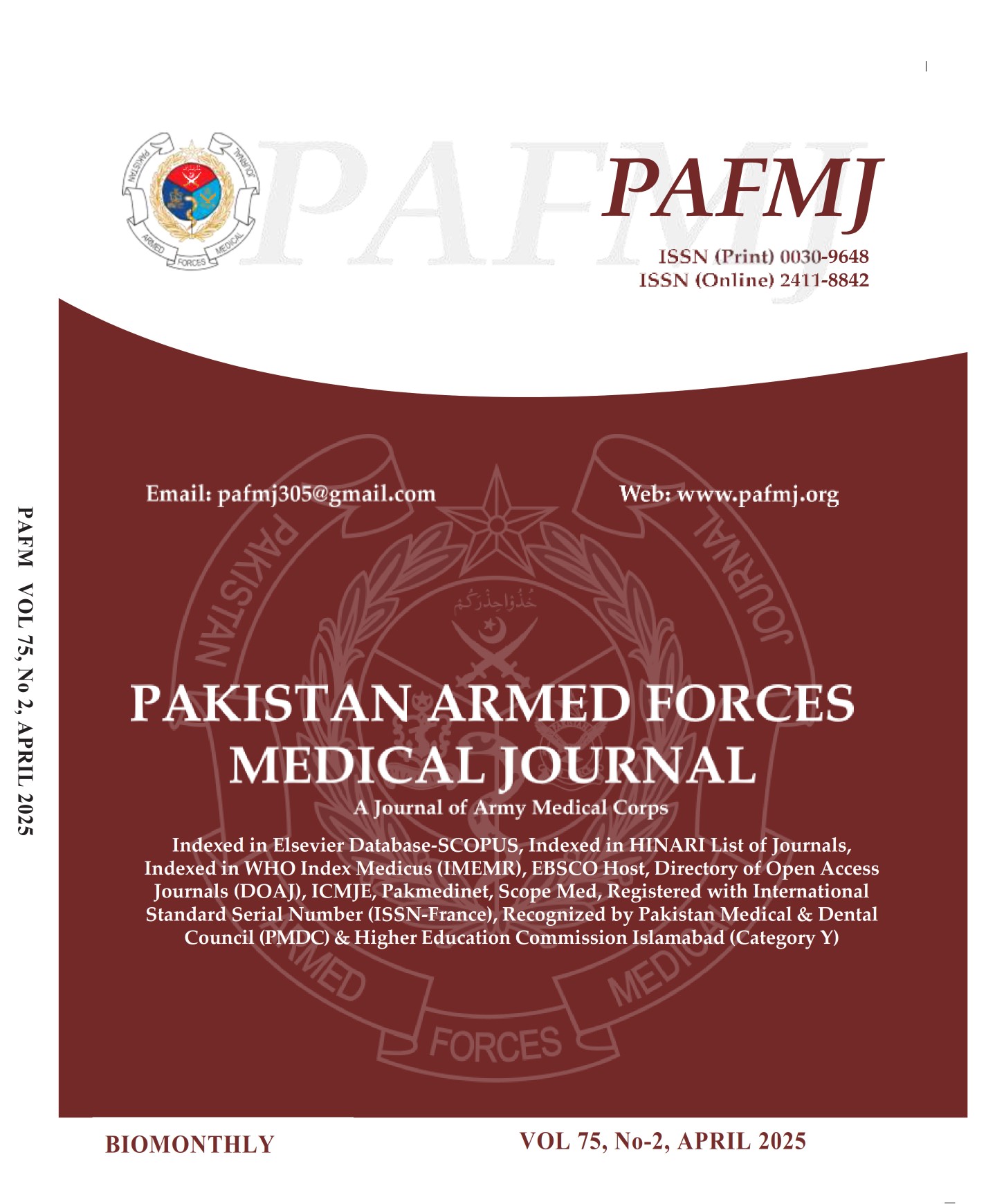Association of Pre-Operative Risk Factors with Abdominal Wound Dehiscence
DOI:
https://doi.org/10.51253/pafmj.v75i2.11399Keywords:
Abdominal wound dehiscence, Anemia, hypertensionAbstract
Objective: To determine the association of pre-operative risk factors with abdominal wound dehiscence.
Study Design: Quasi-experimental study.
Place and Duration of study: Surgical Unit 1 of Combined Military Hospital, Rawalpindi, Pakistan from, Aug 2019 - Jan 2020.
Methodology: A total of 130 cases and 130 controls with ages 20 to 70 yrs were included. Patients with neurological or psychological disorders or who underwent a laparoscopic procedure were excluded. All surgeries were performed by a single team with the assistance of a researcher. Patients were divided into two groups, i.e., Cases with abdominal wound dehiscence and controls without abdominal wound dehiscence. Patients were evaluated for risk factors, i.e., advanced age, male gender, anemia, emergency surgery, diabetes, and hypertension.
Results: Mean age of patients in case group was 46.69±10.16 years, and in control group was 44.57±10.35 years. Preoperative risk factors for abdominal wound dehiscence in cases and controls were as follows; advanced age (7.69% vs. 3.08%), male gender (37.69% vs. 32.31%), hypertension (40% vs. 21.54%), diabetes (30.77% vs. 20.0%), anemia (83.08% vs. 50.0%) and emergency surgery (70.77% v. 48.46%).
Conclusion: Risk factors like hypertension, diabetes mellitus, anemia and emergency surgery are the major risk factors for abdominal wound dehiscence.
Downloads
References
Ellis H. Midline abdominal incision. Br J Obstet Gynecol 1984; 91(1): 1-2.
https://doi.org/10.1111/j.1471-0528.1984.tb05269.x
Riou JPA, Cohen JR, Johnson H. Factors influencing wound dehiscence. Am J Surg 1992; 163(3): 324-330.
https://doi.org/10.1016/0002-9610(92)90014-i
Townsend, Beauchamp, Evers, Mattox. Sabiston Textbook of Surgery. Ed. 20th, Philadelphia; Elsevier 2016: 449.
Christoph M Seiler, Thomas Bruckner, Markus K Diener, Armine Papyan, Henriette Golcher, Christoph Seidlmayer, et al. Interrupted or continuous slowly absorbable sutures for closure of primary elective midline abdominal incisions: A multicenter randomized trial. Ann Surg 2009; 249: 576-582.
https://doi.org/10.1097/sla.0b013e31819ec6c8
Krukowski ZH, Cusick EL, Engeset J, Matheson NA. Polydioxanone or polypropylene for closure of midline abdominal incisions: A prospective comparative clinical trial. Br J Surg 1987; 74: 828-830.
https://doi.org/10.1002/bjs.1800740927
Corman ML, Veidenheimer MC, Coller JA. Controlled clinical trial of three suture materials for abdominal wall closure after bowel operations. Am J Surg 1981; 141: 510-513.
https://doi.org/10.1016/0002-9610(81)90150-1
Gokak AV, Ramesh H, Abhijit D, Vasant T. KIMS 14: a new scoring system to predict abdominal wound dehiscence following emergency laparotomy. Int Surg J 2017; 4(4): 1230-1234. https://doi.org/10.18203/2349-2902.isj20170986
Sandy‐Hodgetts K, Carville K, Leslie GD. Determining risk factors for surgical wound dehiscence: a literature review. Int Wound J 2015; 12(3): 265-275.
https://doi.org/10.1111/iwj.12088
Van Ramshorst GH, Nieuwenhuizen J, Wim CJ, Arends P, Boom J, Jeekel J, et al. Abdominal Wound Dehiscence in Adults: Development and Validation of a Risk Model. World J Surg 2009: 7; 34(1): 20–27.
https://doi.org/10.1007/s00268-009-0277-y
Poole GV Jr. Mechanical factors in abdominal wound closure: the prevention of fascial dehiscence. Surgery 1985; 97: 631–640.
Carlson MA. Acute wound failure. Surg Clin North Am 1987; 77: 607–636. https://doi.org/10.1016/s0039-6109(05)70571-5
Webster C, Neumayer L, Smout R et al. National Veterans Affairs Surgical Quality Improvement Program. Prognostic models of abdominal wound dehiscence after laparotomy. J Surg Res 1983; 109: 130-137.
https://doi.org/10.1016/s0022-4804(02)00097-5
Pereira-Rodríguez JA, Bravo-Salva A. Defining High-Risk Patients Suitable for Incisional Hernia Prevention. J Abdom Wall Surg 2023; 3:2: 10899.
https://doi.org/10.3389/jaws.2023.10899
Gislason H, Grønbech JE, Søreide O. Burst abdomen and incisional hernia after major gastrointestinal operations—comparison of three closure techniques. Eur J Surg 1995; 161: 349–354.
Armstrong CP, Dixon JM, Duffy SW, Elton RA, Davies GC. Wound healing in obstructive jaundice. Br J Surg 1984; 71: 267–270. https://doi.org/10.1002/bjs.1800710405
Aksamija G, Mulabdic A, Rasic I, Aksamija L. Evaluation of Risk Factors of Surgical Wound Dehiscence in Adults After Laparotomy. Med Arch 2016; 70(5): 369–372.
https://doi.org/10.5455/medarh.2016.70.369-372
Waqar SH, Malik ZI, Razzaq A, Abdullah MT, Shaima A, Zahid MA, et al. Frequency and risk factors for wound dehiscence/burst abdomen in midline laparotomies. J Ayub Med Coll Abbottabad 2005; 17(4): 70-3.
Verma S, Patil SM, Bhardwaj A. Study of risk factors in post-laparotomy wound dehiscence. Int Surg J 2018; 5: 2513-217.
Downloads
Published
Issue
Section
License
Copyright (c) 2025 Kamran khan Durrani, Sohail Ilyas, Usman Shah, Naveed ., Ateeq Ur Rehman, Habib Ur Rehman

This work is licensed under a Creative Commons Attribution-NonCommercial 4.0 International License.















